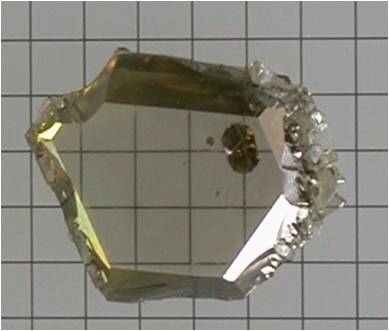An acronym you have probably seen a whole lot of in recent years is LED, or Light Emitting Diode. Long used only for low-intensity illumination (think of the blinking lights on the front of your computer), the new generations of LEDs are being used to replace all sorts of light sources from car head lights to flat panel televisions to the common light bulb. Compared to old style incandescent (or filament) bulbs and even the new compact fluorescent bulbs, LEDs use much less energy to generate the same amount of light and last longer than both other types of bulb.

To begin to understand how an LED works, let’s start by breaking down the acronym. The first two words, Light and Emitting, are pretty self-explanatory, but the third word, Diode, might be new to some of you. What a diode is and how it is made is critical to understanding how these marvelous devices work.
The best way to understand a diode is to think of it as a one-way road for electricity. In a normal electrically-conductive material, like a piece of metal wire, electricity can just as easily flow in both directions, just like traffic does on a two way road. In a diode, electricity can only move in one direction. While this is easy to think about, it is very difficult to actually do (electricity doesn’t follow road signs very well).

Electronics – Materials Available
Let’s start by looking at the three broad classes of materials that are used to make electronic devices.
The first type, conductors, are very good at allowing electricity to flow through them. The simplest example of a conductive material is the piece of metal wire at the core of an extension cord. Due to the unique atomic structure of the conductive piece of wire, the flowing electrons that make up electricity can almost effortlessly jump from atom to atom in the wire to deliver electrons from the wall outlet to your computer.
The second type of electrical material, insulators, are the opposite of conductors. They do not allow electrons to easily move through them and thus transmit very little (if any) electricity. A good example of an insulator is the layer of rubber surrounding the metal wire in that extension cord we mentioned earlier. This insulating material keeps you from getting shocked by preventing the electricity from moving out of the wire and into your hand.
The third and final type occupies the large middle ground between conductors and insulators. They are normally called semiconductors, but could just as easily be called semiinsulators. They are not particularly good or bad at conducting electricity. You have probably heard a little about semiconductors and their role in making the computer chips that are at the heart of any modern computer, smartphone or robot vacuum. While pure semiconductors are not particularly useful, the ability for scientists to manipulate the electrical properties of these materials has allowed the creation of all of the computer chips and LEDs and other neat electrical gadgets that we enjoy today.

LED from a plain old semiconductor?
So how do we turn a semiconductor into a LED? Well, there are many different methods, but let’s focus on the method used to make many modern LEDs like the kind used in light bulbs. We’ll start with a piece of a fairly exotic material, gallium nitride. Gallium nitride is a very hard material composed of equal quantities of gallium atoms (look for it on the Periodic Table!) and nitrogen atoms. No one has ever found gallium nitride in nature; the only way to get some appears to be to make it in a lab. Like the silicon used to make computer chips, pure gallium nitride is a semi-conductive material.

But we can’t just turn any semiconductor into a diode. Like a congested two-way street does with cars, a pure semiconductor will conduct electricity equally marginally in both directions. To turn a semiconductor into a diode, we have to control the movement of electrons in one direction. We can do this by creating two flavors of semiconductor: an electron-packed material, and an electron-deficient one. The electrons can then flow from the electron-packed material to the electron-deficient material, but not the other way. To change the electron makeup of the semiconductor, scientists mix in small amounts of chemicals, known as dopants, to either add negatively charged electrons (a n-type (for negative) dopant) or remove them (p-type (for positive) dopant).
So now we have two separate pieces of gallium nitride. One is doped to have a lower electron density (p-doped) and the other is doped to have a higher electron density (n-doped). If we stick these two pieces of gallium nitride together, we have a diode! If we try to flow electricity from the p-doped side to the n-doped side, we will find it doesn’t flow at all. Think of the electrons as cars. If we try to direct cars from a nearly empty road (like the p-doped semiconductor) to a road jam packed with cars (n-doped semiconductor) they aren’t going to be able to move very far before getting stuck. But if we suddenly allow the cars from the overly congested road onto the practically empty street, they’re going to flow very easily.

What about the light?
But how do we turn this interesting electronics parlor trick into light? Well, it turns out that the electrons in the n-doped gallium nitride have a bit more energy than their counterparts in the p-doped side. Thus, as electricity moves through the semiconductor, the electrons moving from the n-doped side of the diode to the p-doped side fall off a little bit of an energy cliff. The “height” of this cliff is due to the properties of the materials we used. Just like dropping some object off a real world cliff, when the electrons fall down from the higher energy level of the n-doped side to the lower energy level of the p-doped side, they have to do something with the extra energy. In the real world, most of this energy is released into the object when it hits the ground (usually breaking it). In our LED, this energy can be released in two ways. If we’ve done a poor job designing our LED, the “fall” of the electrons release this energy as heat. If we’ve done a good job designing our LED, the electrons release this excess energy as a photon, the basic unit of light. Thus a Light Emitting Diode is born!

While our new LED can now release light, we have one last step to make it really useful. Because of the unique way they create light, LEDs only emit photons over a narrow range of wavelength (or color). The gallium nitride LEDs we used in our example only emit blue-colored light. While this ability is useful for something like an indicator light on a computer, only emitting one color doesn’t work well very well for making a light bulb. Most of us would prefer that our light bulbs give off white light. White light is actually a mix of all of the different wavelengths of visible light. So how to do we turn the single wavelength of light emitted from a LED into nice white light? One of the most popular ways is to coat the outside of the bulb enclosing the LED with another special chemical called a phosphor. The phosphor adsorbs the mono-color light emitted by the LED and emits a wide range of colored light. Our eyes perceive this range of colors as white light. This is similar to how fluorescent lighting works.
Looking forward
Some of the most exciting developments in LED technology are being made in the phosphor area. Traditionally, phosphors have been made with some rare elements such as yttrium and cerium. Due to their rarity and distribution, extracting and processing these elements to make phosphors is both environmentally and economically costly. Some of the newest developments in phosphor technology have been advanced nano-particles that are even better at emitting eye-pleasing white light than the yttrium and cerium phosphors. These nano-particles, made out of relatively common and cheap silicon, have the potential to lower LED prices while also decreasing the environmental impact of their manufacture.
As our understanding of the technology of LEDs continues to improve, their cost will only decrease while their usefulness vastly increases. 50 years from now, it is likely that LEDs of all colors will be ubiquitous in all aspects of our technological and day-to-day lives. Who knows, there might even be a new technology that is even more efficient than LEDs that will further reduce our energy consumption and make our society more sustainable.
